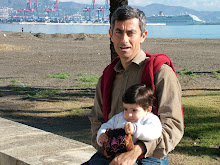A volcano is an opening, or rupture, in a planet's surface or crust, which allows hot, molten rock, ash, and gases to escape from below the surface. Volcanic activity involving the extrusion of rock tends to form mountains or features like mountains over a period of time.
On May 18th, 1980 the eruption of Mount St. Helens in southwest Washington state disrupted the lives of thousands and changed more than 200 square miles of rich forest into a grey, lifeless landscape. Now, more than twenty-six years later, the land around the mountain is slowly healing. Nature may be covering the scars of the 1980 eruption, but many people will never forget what happened that spring day.
The different parts of a Volcano
The image below shows the different parts of a volcano.
Magma - Molten rock beneath Earth's surface.
Parasitic Cone - A small cone-shaped volcano formed by an accumulation of volcanic debris.
Sill - A flat piece of rock formed when magma hardens in a crack in a volcano.
Vent - An opening in Earth's surface through which volcanic materials escape.
Flank - The side of a volcano.
Lava - Molten rock that erupts from a volcano that solidifies as it cools.
Crater - Mouth of a volcano - surrounds a volcanic vent.
Conduit - An underground passage magma travels through.
Summit - Highest point; apex
Throat - Entrance of a volcano. The part of the conduit that ejects lava and volcanic ash.
Ash - Fragments of lava or rock smaller than 2 mm in size that are blasted into the air by volcanic explosions.
Ash Cloud - A cloud of ash formed by volcanic explosions.
Types of Volcanoes
There are 3 different types of volcanoes:
1. Active - eruptions can be anytime and often.
2. Dormant - has been a while since it has erupted, but could at anytime.
3. Extinct, meaning it hasn't erupted in a very long, long time so it probably won't ever again.
Shapes of Volcanoes
How many different shapes of volcano are there?
The type of magma in the earth creates four different types volcanoes:
Shield Volcano - flat
If the magma is runny, the gas can escape easily and there will not be an explosion. The magma just comes out of the mountain and flows down the sides.
Shield volcanoes are shaped like a bowl or shield in the middle with long gentle slopes made by the lava flows.
Examples include the volcanoes in Hawaii and Mount Etna.
Composite Volcano - tall and thin

If the magma is thick and sticky (like honey), the gas cannot escape, so it builds up and up until it explodes sending out huge clouds of burning rock and gas.
Composite volcanoes are steep-sided volcanoes composed of many layers of volcanic rocks, usually made from thick sticky lava, ash and rock debris (broken pieces).
Composite volcanoes are also known as strato-volcanoes.
Examples include Mount Fuji in Japan, Mount St. Helens and Mt. Etna in Italy.
Cinder cones

Cinder cones are circular or oval cones built from erupting lava that breaks into small pieces as it shoots into the air. As small pieces fall back to the ground, they cool and form cinders around the vent.
Lava domes
Lava domes are formed when erupting lava is too thick to flow and makes a steep-sided mound as the lava piles up near the volcanic vent.
SUBMARINE ERUPTIONS
A submarine eruption is a type of volcanic eruption where lava erupts under an ocean. Most of the Earth's volcanic eruptions are submarine eruptions, but few have been documented because of the difficulty in monitoring submarine volcanoes. Most submarine eruptions occur at mid-ocean ridges and near hotspots.
1. Water vaper cloud
3. Stratum
4. Lava flow
5. Magma condiut
6. Magma chamber
7. Dike
8. Pillow lava
ACTIVITIES ABOUT VOLCANOES
Crossword (easy) -----> with keys
Crossword (medium) -----> without keys: Send me your answers!!
Wordsearch -----> with keys
Unscramble words -----> with keys
Quiz -----> without keys: Send me your answers!!
Click here to read a transcription.
Try to guess the missing words (15) and send me your answers!
===========================================









